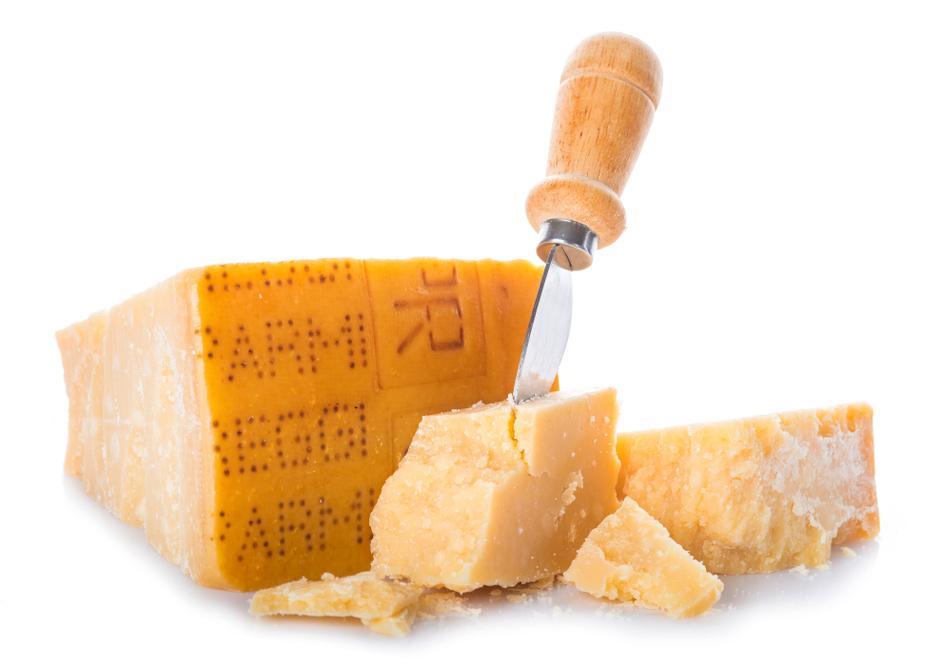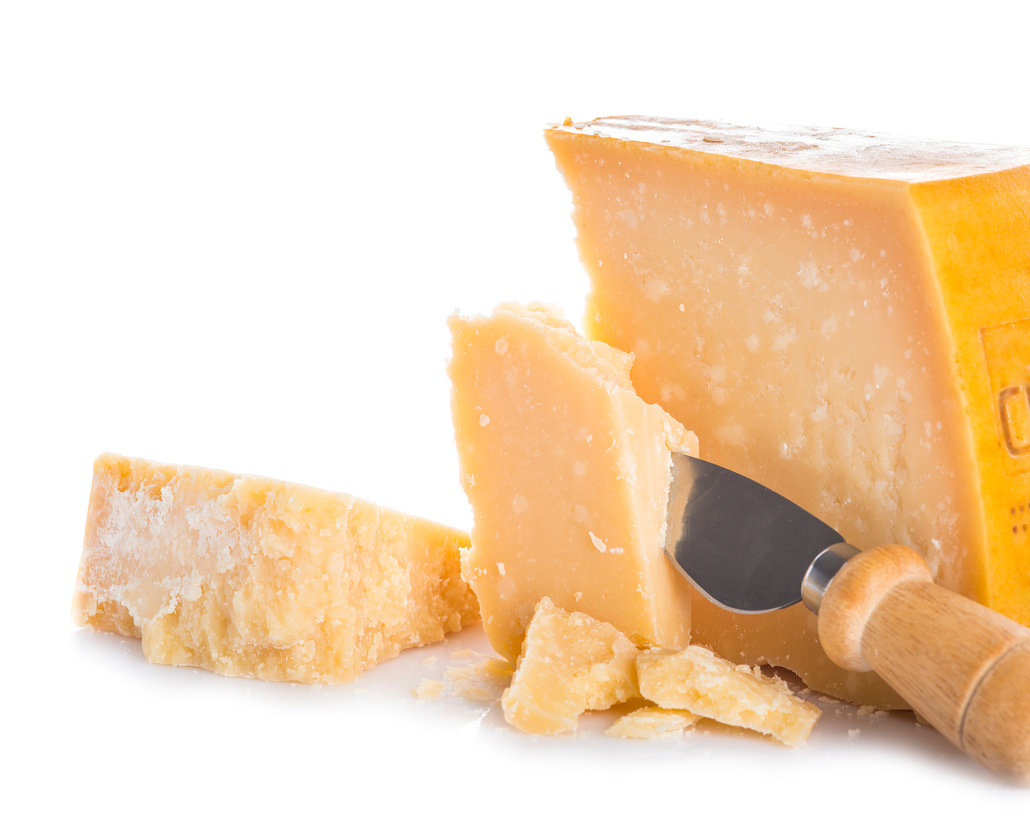Parmigiano-Reggiano
Parmigiano-Reggiano is a cooked, hard cheese that is produced from partly skimmed cow’s milk. Parmigiano-Reggiano is one of the great aged cheeses from the Emilia region of Italy. It is characterized by its strong, long-lasting flavor and granular (scaly) structure, which means that it splits easily into thin flakes.
The cheese is shaped like a disk and weighs between 33 and 36 kilos (4 lb. 8 1/2 oz.-5 lb.). It has a diameter of 46 cm. (18 in.) and is 23 cm. (9 in.) tall. The cheese has a rind of a yellow-old gold color that is approximately 5 mm. (about 1/8 in.) thick. It is velvety, with barely perceptible pores. The flavor, which is unique, is yielding and delicate. Parmigiano is highly nutritious, with an elevated content of proteins. Each 100 grams (3 1/2 oz.) provides about 411 calories.

The cheese is made in the provinces of Reggio Emilia, Modena, Bologna (in the area on the left bank of the river Reno) and Mantua (in the territory on the right bank of the Po). It became a Protected Designation of Origin (PDO) cheese in 1955. Its production is governed by a strict Standard, registered with the European Community. Parmesans are the cheeses modeled after Parmigiano-Reggiano and produced in regions other than mentioned above.
Parmigiano pairing tips
It can be eaten at room temperature as an appetizer or paired with a number of other Italian foods. Traditionally, Parmigiano-Reggiano is paired with other products from the region, fruit of the same land, climate and culinary know-how. Try pairing the cheese with ripe pears or a couple drops of Traditional Balsamic Vinegar from Modena, and in terms of wine with Lambrusco or Malvasia from Parma.
If instead you prefer to further enhance its distinctive flavor, pair the cheese with dishes of equally strong flavors and persistent aromas. When flavors are well paired, no single flavor should cover or mask another. Here are some examples of foods and wines with similar body.
In terms of wine, try pairing well-aged Parmigiano with a structured Italian red like Barolo or Brunello di Montalcino. Medium-aged Parmigiano is perfect with Champage and rose wines.
In terms of jams, pear with balsamic vinegar is ideal and as for mostarda, try apricot or melon.
If you want to serve honey on the side, look for “tiglio,” chestnut or Erica.
Parmigiano can also be paired with fruits like pears, grapes and strawberries. Also consider serving it with walnuts, dried figs and toasted almonds.
A medium-bodied, aromatic beer also pairs nicely with Parmigiano. Try a Lager for an aperitivo or a Weiss during dinner.

How to serve it
- Grated on sauces, risotto, soups and broiled vegetables like fennel.
- Shaved on beef carpaccio, in salads or on thinly sliced artichokes.
History of Parmigiano-Reggiano cheese
It appears that the Etruscans, and the Latins as well, were acquainted with this cheese and appreciated its qualities. It was reported in the tales of Giovanni Boccaccio and in other accounts of the late medieval period that the cheese was regularly found on the tables of the well-to-do. The most authoritative culinary texts indicate that the cheese was extensively used in cooking. Over the centuries, it has enjoyed the reputation of being “the king of cheeses.”
Production
In the year of its production or the one just past, a parmesan cheese is called “new.” It is vecchio (old) when it has been aged 18 to 24 months and stravecchio (extra-old) when it is between 24 and 36 months of age.
Only milk produced between May 1 and November 11 is used in producing the cheese. Outside that period, the characteristics of the milk are much different and it is impossible to obtain a cheese with the requisite level of quality. It appears that the best parmesan is the one made during the month of September and known, therefore, as the settembrino. The processing begins in the casello or cheese plant, which collects the output of the milk producers. The milk is allowed to “rest” overnight and more fresh milk, which has “rested” only an hour, is added the following morning.
The milk is then run off into large caldrons in the shape of bells turned upside down. The starter is blended with the milk, which is heated to 36 degrees C. (96.8° F.) and constantly stirred. The rennet is added and curdling takes about 10 to 12 minutes. The curds are broken up and reduced to the size of small grains, while the mixture is heated. The mass of curds is then extracted from the caldron in hemp sacks and placed in wooden molds. The date of the cheese’s production is stamped into the surface. The cheese is soaked in brine for about 25 days. It is then removed from the solution and dried in the sun. The cheese is aged in special rooms where it is constantly checked by experts who test it by thumping it with a martelletto or small hammer.
How to store Parmigiano cheese
Parmigiano should be stored in a dry place. Slices that have been vacuum-packed can be stored in the refrigerator for a couple of months. Slices that have not been vacuum-packed should be loosely wrapped in plastic wrap or aluminium foil, so that the rind can breath, and placed in a container in the fridge.
The numbers
- 0 preservatives or additives
- 12 months of minimum maturation
- 22-24 months of average maturation
- 16 litres of milk for 1 Kg of Parmigiano-Reggiano
- 600 litres of milk for 1 wheel of cheese
- 38.5 kg average weight of 1 wheel
- 4,414 farms delivering milk to dairies (year 2006)
- 250,000 cows producing milk for Parmigiano-Reggiano
- 15% ca. of the Italian milk production
